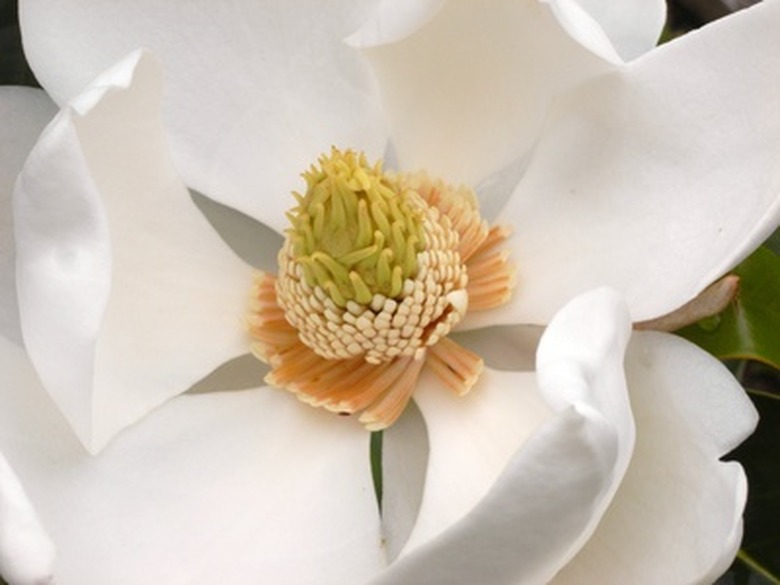Comparison Of Southern Magnolia & Sweetbay Magnolia
Among the most beautiful flowering trees native to the American Southeast, both the southern magnola (Magnola grandiflora) and sweetbay magnolia (Magnolia virginiana) trees produce deliciously fragrant blooms. Either tree can be grown in full sun to partially shaded locations in the landscape, although abundant sunlight produces more fully structured plants that produce more flowers. Southern magnolia is appropriate to grow in USDA winter hardiness zones 6b through 9, while sweetbay is grown across zones 5b through 9.
Among the most beautiful flowering trees native to the American Southeast, both the southern magnola (Magnola grandiflora) and sweetbay magnolia (Magnolia virginiana) trees produce deliciously fragrant blooms. Either tree can be grown in full sun to partially shaded locations in the landscape, although abundant sunlight produces more fully structured plants that produce more flowers. Southern magnolia is appropriate to grow in USDA winter hardiness zones 6b through 9, while sweetbay is grown across zones 5b through 9.
Native Ranges
Native Ranges
Southern magnolia is native primarily within a wide band from eastern Texas to southern South Carolina. Its range extends as far south as the middle of the Florida Peninsula, and small isolated pockets occur in slightly more northern reaches, including North Carolina.
Sweetbay magnolia's native range is much larger. It extends from southern New Jersey southeast across the Atlantic coastal plain to South Carolina and then westward to Tennessee, Arkansas and eastern Texas. In Florida, sweetbay magnolia extends nearly three-fourths down the peninsula. Isolated populations of sweetbay occur on Long Island and in coastal eastern Massachusetts.
- Among the most beautiful flowering trees native to the American Southeast, both the southern magnola (Magnola grandiflora) and sweetbay magnolia (Magnolia virginiana) trees produce deliciously fragrant blooms.
- Its range extends as far south as the middle of the Florida Peninsula, and small isolated pockets occur in slightly more northern reaches, including North Carolina.
Growth Characteristics
Growth Characteristics
Southern magnolia becomes a densely foliaged evergreen tree with a broad, pyramid-like shape. It grows 20 feet to 60 feet tall and 30 feet to 50 feet wide (although modern garden varieties vary in their mature size and growth habits). Sweetbay magnolia by contrast is variable in habit, primarily because of climate. In colder winter regions it remains shrub-like, while elsewhere it attains tree-like proportions. As a tree, it matures to 25 feet to 30 feet tall and 15 feet to 20 feet wide. It is slightly cone-shaped, but with potential for irregular branching and form. Sweetbay is also deciduous in winter, or partially evergreen if winters are mild.
- Southern magnolia becomes a densely foliaged evergreen tree with a broad, pyramid-like shape.
- In colder winter regions it remains shrub-like, while elsewhere it attains tree-like proportions.
Ornamental Features
Ornamental Features
Southern magnolia's leaves are large ovals, measuring to 8 inches long. They are leathery and glossy, dark green with fuzzy, rust-colored undersides. The large, cup-shaped white flowers measure up to 10 inches in diameter, with nine to 12 petals. Fragrant, the flowers appear on branch tips as early as mid-March in Florida (summer's start) to June in more northern areas, and continue sporadically into early autumn. Sweetbay magnolia foliage is smaller, to 6 inches long and narrower, but still long and oval. Its leaves are brighter, lighter green and glossy with a whitish color on leaf undersides. The creamy white flowers measure 3 inches to 4 inches in diameter, with six to nine petals, and fade to yellow when old. The scent of the sweetbay's flowers is a blend of lemon and rose. Flowering season starts and ends slightly earlier than that of the southern magnolia wherever it grows, according to the American Horticultural Society's "A-Z Encyclopedia of Garden Plants."
- Southern magnolia's leaves are large ovals, measuring to 8 inches long.
- The creamy white flowers measure 3 inches to 4 inches in diameter, with six to nine petals, and fade to yellow when old.
Horticultural Merit
Horticultural Merit
Both trees are revered by gardeners, particularly for their display of fragrant white flowers during the warm months. Southern magnolia becomes larger, remains evergreen in winter and traditionally in the American South and East the foliage and seed structures are used for Christmas decorations in garlands and wreaths. Southern magnolias make stately shade trees for parks as well as large-scale screening hedge rows. Sweetbay magnolias are used mainly for singular specimen trees in a garden, especially if soils are wet. In colder regions, sweetbays are grown as shrubs and provide the pretty flowers where the southern magnolia might not survive.
Growing Considerations
Growing Considerations
Both magnolia trees grow best in moist, fertile soil rich in organic matter and acidic in pH (6.5 or lower). Once established, the southern magnolia is much more tolerant of dry soils and seasonal droughts. Conversely, sweetbay magnolia relishes damp to waterlogged soils. While southern magnolia can withstand a brief period of standing water over its roots, it eventually can lead to root rot and kill the plant. Sweetbay can grow where shallow water pools, and it will last for months on end.
- Both trees are revered by gardeners, particularly for their display of fragrant white flowers during the warm months.
- Sweetbay magnolias are used mainly for singular specimen trees in a garden, especially if soils are wet.
References
- "Dirr's Hardy Trees and Shrubs"; Michael A. Dirr; 1997
- U.S. Forest Service: Magnolia grandiflora
- U.S. Forest Service: Magnolia virginiana
- "A-Z Encyclopedia of Garden Plants"; Christopher Brickell and H. Marc Cathey, eds.; 2004
- "A Gardener's Guide to Florida's Native Plants"; Rufino Osorio; 2005
